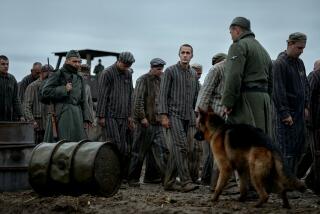Review: Matthew Rhys provides only real glimmer in WWII drama ‘Come What May’
- Share via
In “Come What May,” director Christian Carion dramatizes the other side of the World War II front line — the civilians fleeing invading troops. The images of uprooted, desperate travelers can’t help but remind one of contemporary refugee crises. Yet with its old-fashioned gloss, the incident-packed story proves only mildly engaging and finally has little to say.
Carion’s latest historical drama is closer in tone to the feel-good reassurance of his Oscar-nominated “Joyeux Noel” than his tense and fascinating Cold War thriller “Farewell.” Even with its (not entirely convincing) scenes of dive-bombing Stukas, the movie is designed primarily to comfort.
Experiences that should pack an emotional punch instead feel like stagecrafted moments. An exception among the thinly conceived characters is the turn by Matthew Rhys, star of the FX series “The Americans,” as a Scottish soldier. A dash of swashbuckling complexity, it’s the best thing about the film.
The lack of depth charges beneath the polished surface is a shame when Carion is shining a light on a little-explored aspect of the war. Drawing on the memories of his mother and others who were part of the 1940 exodus, he focuses on one village among the 8 million French residents who packed up their horse-drawn carts as the Nazis advanced through northern France.
Despite some confusing, choppy scene-setting jumps between Germany and France, the film opens with a strong sequence that succinctly explains the exile of a widowed German and his young son. Anti-Nazi activist Hans (August Diehl) and 8-year-old Max (Joshio Marlon) wind up in the rural village of Lebucquière, posing as Belgians. But when his true nationality is discovered, Hans is arrested on suspicion of being a spy. From there, Carion and his co-screenwriters, Andrew Bampfield and Laure Irrmann, weave a two-stranded narrative, moving between father and son as they try to find each other while fleeing the Nazis.
Hans, set free from prison amid the Germans’ bombing, ends up traveling with Percy (Rhys), a member of the British army who’s the sole survivor from his infantry unit. Max is on the road with the evacuating Lebucquière villagers, led by the mayor (Olivier Gourmet) and his café owner wife (Mathilde Seigner). The young schoolteacher Suzanne (Alice Isaaz), herself an orphan, takes a special interest in the boy, symbolically adopting him and gently preparing him for the worst, certain that Hans is dead.
Relying on dramatic coincidences and overusing Ennio Morricone’s romantic score, Carion isn’t able to build momentum or resonance from the episodic action. He bookends the film with archival footage and still photographs of the actual exodus, and the haunting images of the people in those caravans are more stirring than anything in the movie itself.
Some individual scenes prove involving, though, and there are harrowing details — Max’s encounter with a dying soldier; the nefarious machinations of a director (Thomas Schmauser) of Nazi propaganda films — but the overall effect is distant and blandly gentle. When, in an unexpected and thought-provoking shift in perspective, Carion focuses on a German infantryman’s trembling terror, you can sense the director reaching for something and wish he’d pushed against the grain elsewhere.
At the other end of the spectrum, he uses a pet goose’s reaction shots to convey a sense of continuity and normalcy amid the devastation. It’s a device that manages to avoid cutesiness and feels like a token of meaning in a world gone mad, not unlike the familiar yet affecting gesture that becomes a kind of motif: strangers giving one another messages, notes and objects to pass along.
Yet the screenplay reduces central characters as well as key supporting figures to one-note types, among them the villager (Laurent Gerra) who’s reluctant to leave his wine cellar. Beyond dialogue that explains what’s already evident, the actors have little to work with. That makes Marlon’s thoughtful, silent reactions as a child cast adrift, and Carion’s alertness to their eloquence, all the more welcome.
And Rhys, with eye-opening silver-screen panache, manages to find nuance in the material; embracing its old-school earnestness, he combines a devilish glint with a soulful weight. With his character’s dramatic exit from the action, the movie effectively ends. Except that it continues, lumbering toward its predictably sentimental conclusion.
-------------
‘Come What May’
In French, English and German with English subtitles
MPAA rating: R, for some war violence/bloody images
Running time: 1 hour, 53 minutes
Playing: Laemmle’s Monica Film Center, Santa Monica; Laemmle’s Town Center 5, Encino
See the most-read stories in Entertainment this hour »
Movie Trailers
More to Read
Only good movies
Get the Indie Focus newsletter, Mark Olsen's weekly guide to the world of cinema.
You may occasionally receive promotional content from the Los Angeles Times.










